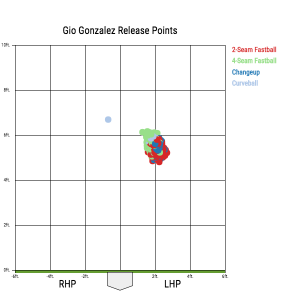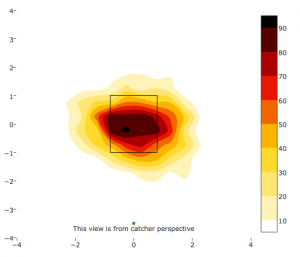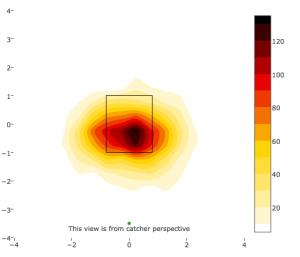Last week, I took a look at some of the most surprising hitters from the 2017 season and their early ADP outlooks for 2018.
This week, the focus shifts to a group of surprising pitchers -- starters and closers -- from 2017 with a similar mindset.
The ADP data included with this article is from mock drafts hosted by Justin Mason of FanGraphs and Friends with Fantasy Benefits.
Luis Severino, SP, NYY ($25) | MMADP: 37.25 -- He ended up on my list of assigned player outlooks for the upcoming 2018 RotoWire Fantasy Baseball Guide. Here's a quick preview of Severino's outlook, which sums up my stance on him following his breakout:
A year later than expected, Severino proved that the flashes he showed as a rookie in the second half of 2015 were indicative of his upside. While Masahiro Tanaka scuffled in the first half, Severino thrived, mixing his arsenal of a high-90s fastball, slider and improved changeup effectively to become one of the best starters in the American League. He threw more pitches in the strike zone than ever before (49.3 percent), held hitters to a lower contact rate on those pitches (82.3 percent), and made hitters chase his pitches outside the zone at the highest rate of his career (31.3 percent). Home runs are still his greatest weakness, and he allowed 15 in 97 innings at Yankee Stadium compared to six in 96.1 innings on the road, but as long as he keeps his walk rate (2.4 BB/9) in check, the long balls are unlikely to derail him. Severino will likely be treated as a top-10 starting pitcher in most draft rooms for 2018, but the increased price and hype appear to be warranted.
Considering his age and pedigree, he probably shouldn't have been falling into the Pick 350 range of NFBC drafts last winter and spring, especially after he was a consistent target in the Top 200 overall entering 2016. The team context, as far as having a great bullpen to protect his leads and plenty of run support, is excellent other than the homer-increasing tendencies of his home park.
Alex Wood, SP, LAD ($20) | MMADP: 92.75 -- At a glance, the overall numbers are great and the underlying peripherals support what Wood accomplished in 2017. My concern is the health of his shoulder, as he experienced velocity fluctuations in the second half of the season and his skills crash during that time included an 18% K% and 1.63 HR/9. Perhaps being a member of the Dodgers gives him a better chance of repeating his success from last season, as the team proved capable of dealing with starting pitchers unable to rack up the typical 200-plus inning workloads as they used the 10-day DL exceptionally well in Year 1 of its existence. We may be in an era of fantasy baseball where several starting pitchers with 150-160 inning projections are considered Top-20 options, and when the ratios and strikeout rates are very good or elite, there is nothing wrong with that. As a frame of reference, there were 21 starting pitchers who earned $13 or more in 2017 in 15-team mixed leagues. Of those 21, the average workload was 179.4 innings. Wood was one of those 21 pitchers, and that group included five pitchers who finished with 150 innings or less, while Wood checked in with the sixth-lowest total (152.1 IP).
Gio Gonzalez, SP, WAS ($19) | MMADP: 216.25 -- Apparently, one excellent season isn't enough to undo several erratic but pretty good ones. Based on the Mason ADPs, it's almost as if 2017 never happened. The pitch mix changed slightly last season, as Gonzalez threw more curveballs (24.7%) and changeups (18.6%) than he did in any of his five previous seasons with the Nats. Here's a look at the release point data (courtesy of Baseball Savant):


Above, 2016 is the first (top) chart, while 2017 is the second (bottom) chart. There isn't much difference in the two clusters. Perhaps something changed with his location?


Bingo.
Once again, the chart on top is from 2016, and the chart on the bottom is from 2017. Gonzalez was locating on the outer edge of the strike zone frequently last season, instead of catching too much of the plate, which he did frequently in 2016. Command is not often the first skill that comes to mind when we think about Gonzalez, but it's an encouraging sign for a guy who sits around 90 mph with his fastball at this stage of his career. The curveball was his best pitch in 2016 (.188 BAA, .271 SLG), so it absolutely made sense for him to throw it more last season (.161 BAA, .208 SLG).
Gonzalez has posted an ERA above 4.00 once (2016) over the last eight seasons. Volatility with his WHIP during that span has kept fantasy owners from fully appreciating what he brings to the table, but he's stable enough to buy in on for 2018 even if you expect him to finish with an ERA a full run above his 2.96 from 2017.
Ervin Santana, SP, MIN ($19) | MMADP: 238 -- At first blush, something about Santana seems similar to Gio Gonzalez. He's another player we thought we had figured out, only to have him perform at a level the optimists would have hoped for five-plus years ago. Skills wise, Santana misses fewer bats and gives up more homers than Gonzalez, so his margin for error seems to be a lot smaller. Working in his favor, however, is an excellent outfield defense led by Byron Buxton and Max Kepler, and the Twins' ability to turn balls-in-play into outs at an elevated rate makes me believe that his .245 BABIP isn't completely fluky. More likely, he'll fall closer to the .285 mark he had in each of his first two seasons with Minnesota. For the past four seasons, Santana has used a similar three-pitch mix (fastball, slider, changeup) to consistently solid results. My greatest concern is the lack of strikeouts against lefties, which is shaping up to become a multi-year problem. Additionally, his slider was the only above-average pitch in his arsenal last season.
Fortunately for Santana, the AL Central may be the most pitcher-friendly division to pitch in for 2018. Even in that arrangement, he's not good enough to be a set-and-forget option, but as a sixth or seventh starter who you'll reserve for tough matchups (Cleveland, most road AL East spots), you could probably do worse. The lack of upside remaining here makes it easy to approach him with the attitude of letting someone else take on the risk at the draft table.
Corey Knebel, RP, MIL ($17) | MMADP: 120.25 -- Knebel (pronounced Ken-Able, somehow) was one of four relievers to carry a strikeout rate above 40% last season (min. 20 IP; Craig Kimbrel, Kenley Jansen and Chad Green were the others), as he emerged as one of the league's best young closers. Opposing batters collected just 48 hits in 76 innings against Knebel in 2017, but he struggled with walks, particularly in the first half of the season (5.5 BB/9, 14.9% BB%) before showing signs of improvement in the second half (3.7 BB/9, 10.4% BB%). The soon-to-be 26-year-old has issued free passes at an elevated clip throughout his career, which might keep him out of the elite tier of ninth-inning options in the long run. Knebel's average fastball velocity soared to a career-high 97.4 mph in 2017, and his curveball was a wipeout pitch that enabled him rack up the whiffs.

Felipe Rivero, RP, PIT ($15) | MMADP: 169.5 -- Like Knebel, Rivero increased the velocity on his fastball by a significant amount, jumping from 95.8 to 98.5 mph last season. Mixing three pitches -- fastball, slider, changeup -- enables Rivero to keep hitters even more off balance than the typical reliever as evidenced here:
Felipe Rivero, Filthy 3 pitch K Sequence, 1-1 count (98mph up/in, 99mph low/outside/protect, 85mph Wipeout Slider). pic.twitter.com/BKrgusPsGR
— Rob Friedman (@PitchingNinja) June 14, 2017
-
While Rivero did not carry an elite strikeout rate, he improved his walk and home-run rates last season, and should have every opportunity to handle the ninth inning throughout 2018 for the Pirates after taking over as the closer for Tony Watson in June. As far as splits go, there's nothing in the home-road or lefty-righty numbers that should give you pause about targeting Rivero as a second-tier option. The only thing working against him is the lack of experience in the role, which might give him slightly less job security than a more established closer, but it's a footnote rather than something instructive.
Chase Anderson, SP, MIL ($14) | MMADP: 213.75 -- An oblique injury in late June prevented Anderson from getting the opportunity to set a new career high in innings pitched last season, and he was one of three Brewers starters who lost significant time from an ailment that was suffered while hitting or running the bases in 2017. Fortunately, the lost time wasn't the result of an arm issue, as elbow and triceps injuries have slowed him in the past. The Brewers were impressed enough by the adjustments to give him a team-friendly contract extension that keeps him under club control with team options through 2021.
In addition to changing his pitch mix by throwing more curveballs and cutters, Anderson was throwing harder than ever in 2017, and the increased velocity on his fastball made that pitch more effective, while he also regained the feel for his changeup, which has been his best offering for most of his career. Last season, Anderson had three pitches generating a double-digit whiff rate, and in addition to the velocity increase, his ability to locate more effectively was a big part of that improvement. The first chart below is a heat map of his pitch locations from 2016, and the second is from 2017. The improvements he made against righties in particular can be attributed to his consistency locating down and away more often than he did in 2016, when he lived in the middle third of the strike zone and was often punished by same-handed hitters.


A sub-200 ADP seems unlikely to stick as draft season progresses, and given the concerns about his ability to stay healthy, it's easy to see him landing in the bottom of the Rich Hill tier, where Anderson is still capable of being profitable if he can log 175-180 innings in 2018.
Brad Peacock, SP/RP, HOU ($13) | MMADP: 188.75 -- Peacock was an extremely valuable piece of the Houston pitching staff in 2017, long before his contributions in the postseason. When the rotation battled injuries during the regular season, Peacock not only chewed up innings, but he also pitched at a very high level, throwing his slider at a career-high 37.5% clip. That pitch is one that he retooled at Triple-A thanks to the help of a teammate in 2016, as noted in the linked piece written by Jeff Sullivan of FanGraphs. With a walk rate that still hovers around 4.0 BB/9 (10.4% in 2017), Peacock needs to maintain a low hit rate in order to avoid becoming a WHIP liability. His pitch mix is mostly fastball-slider, with the occasional curveball or changeup sprinkled in.
As a starter last season, Peacock's third time through the order presented a lot of issues. His ERA soared to 8.84 in that split as opposing hitters put together a .321/.413/.588 line against him. Clearly, he's part of an organization that will adjust accordingly and go to the bullpen as needed, but the five-and-fly potential remains very high. Unless he becomes more efficient, or adds a more reliable third pitch, Peacock appears unlikely to take another step forward, but the Astros would probably be satisfied with a repeat of his 2017 numbers.
Charlie Morton, SP, HOU ($12) | MMADP: 235.5 -- The Astros bought in on Morton early last offseason, seeing potential in his velocity surge in a small window of starts with the Phillies before a torn hamstring ended his season in April of 2016. With the extra life on his fastball, Morton was able to pile up strikeouts at the best clip of his career, and he became excellent against left-handed hitters after being among the worst pitchers in baseball against them in the years prior, which led him to the best overall season he's ever had as a 33-year-old. In addition to the surge in strikeouts, Morton continued to post a groundball rate above 50 percent. Skills wise, everything that we saw from him before 2016 doesn't really matter anymore, but the injury history is the overwhelming concern.
I'm not sure you can watch him pitch and let him pass by when you will have an opportunity to take him after the first 10 rounds of most drafts.
Check out this gem from Game 7 of the World Series:
Given the huge difference in price, I would much rather wait and take Morton than pay sticker price for Alex Wood, and the only starter in this piece that will be projected and ranked significantly better than Morton is Severino.
Zack Godley, SP, ARI ($10) | MMADP: 105.25 -- My Short Hops co-host Bernie Pleskoff sees Godley more often than anybody I know. Even when Godley struggled last year, Bernie was adamant that there was something here to get excited about. I was always on the pessimistic side of Godley's long-term outlook, seeing an innings-eater in the long haul rather than a guy who could become an interesting mid-rotation starter with strikeout upside. As a result, I did not reap the benefits when things clicked last season. If 2017 is any indication, Bernie was right all along, as Godley delivered a career-high 13.3% swinging-strike rate (tied for 10th in MLB among starters, min. 100 IP) and struck out more than a batter-per-inning for the first time in his career. While the whiffs ticked up in the second half, the ERA topped 4.00, as he struggled to keep the ball in the yard. Having to pitch half of his games at Chase Field adds a degree of difficulty, but Godley's sinker, curveball and changeup allow him to keep the ball on the ground when he keeps those offerings down in the strike zone.
So, he's better than I thought, but is he good enough to target around the Top-100 in 2018?
Using the "Alex Wood test" he might be, as I would prefer Godley over Wood for next season, but that has more to do with concerns about Wood's health than anything else. I'm erring on the side of caution if he's consistently taken before the end of Round 7 of 15-team mixers, as I can't quite shake the idea that the league started to figure out his curveball-heavy arsenal during those second-half struggles.
Follow me on Twitter @DerekVanRiper.



